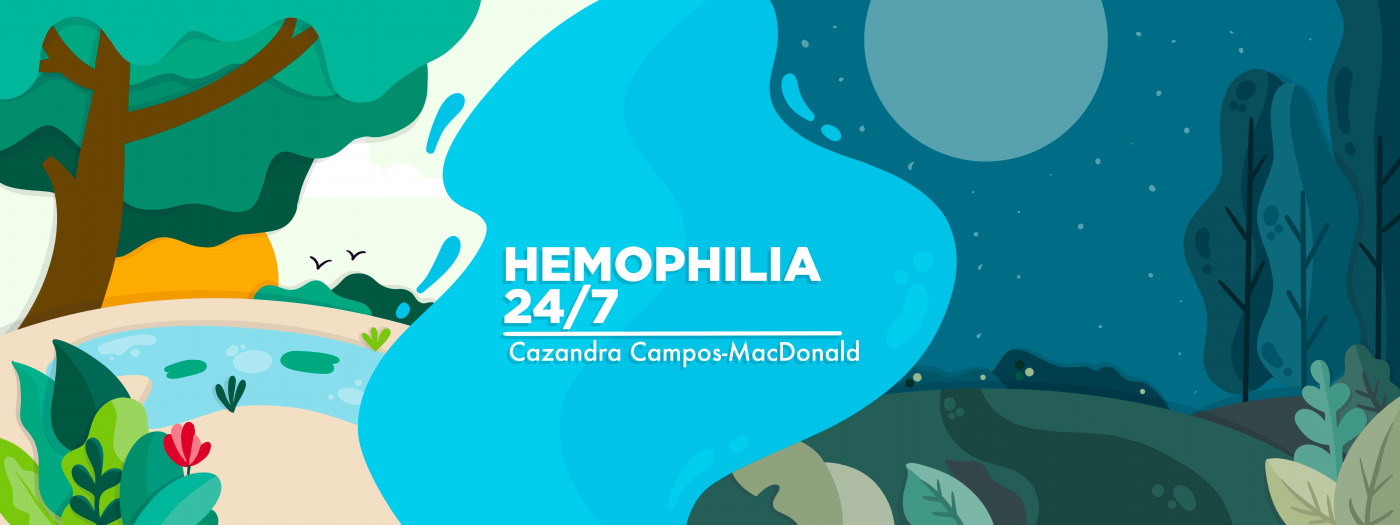The spectrums of color and pain for a young man with hemophilia
How chronic pain affects the way my 18-year-old son sees the world

My 18-year-old son, Caeleb, is an artist. When he starts talking about colors, a lengthy conversation will ensue. Now in college majoring in digital arts, he’s passionate about his field, and his love of color runs deep.
Art has been a saving grace for Caeleb, who lives with severe hemophilia A and an inhibitor. For years, he was never seen without a sketchbook and pencils in hand. Now, you never see him without his iPad.
Caeleb’s right knee and ankle sustained irreparable damage from years of joint bleeds. As a result, his pain is often debilitating. Many people with bleeding disorders, including hemophilia, are able to live relatively healthy lives with few, if any, major complications. Unfortunately, the complications Caeleb endures cause him to live as a person with a disability.
I spoke in person to Caeleb about pain, and he shared openly, wanting his voice to be heard.
CCM: Caeleb, have you made peace with your pain?
CM: No. I hate it and will never make peace with it.
What gets you through each day?
Hope. Hope because I have such a good support system and circle of friends. Even though we live in different parts of the country, we talk daily via Discord. Engaging with my friends and playing video games take my mind off the pain. I hope my pain will get better because I feel like a prisoner.
What is one of your biggest worries?
I worry that when I have a good day or push myself, the next day will be painful to the point of not being able to get out of bed. I wish each day was consistent.
When you have one of those high-pain days, how do you get out of bed?
Well, I have some obnoxious parents. [He grins.] Limping through the day instead of sitting down all day is the better choice. It’s these times when my mind can be dangerous as I dwell on what is happening to my body.
Caeleb, you use several mobility aids, including a cane, a walker, a manual and an electric wheelchair. How do you feel when using one?
I feel old. Eighteen-year-olds should not need a wheelchair. Being young [and] using mobility aids makes me feel misplaced. I feel like I’ve accelerated 60 years with how my body feels.
Also, don’t help a wheelchair user without asking first. When a well-meaning person begins to push me, I feel violated. It takes away the little control that I have. It is my right to wheel myself.
How does it feel when you need to ask for help?
I feel insecure, especially when I am alone at school.
What do you wish people knew about your pain?
Pain is incredibly restrictive. It takes a lot of ability to move. When someone gets up, walks out the door, and goes to the opposite side of the campus, they don’t think about walking. It is a task that is taken for granted. You don’t realize it until [the ability] is gone.
Caeleb, do you have any final thoughts?
I get frustrated when someone tells me about the pain they experienced after falling off a skateboard. It is not the same as what I live with.
I relate pain to the color spectrum. Most people without chronic pain see vibrant, cheerful colors. I see dark, cold colors, especially when pain is high. We all agree that we see colors, but they are not the same, just like pain. The spectrum of colors overlaps but may never fully blend.
***
I appreciate Caeleb’s openness. When he talked about colors, it helped me consider the colors in my life. Someone without chronic pain may experience a shift in their perception of the color spectrum when they encounter hardship or emotional distress, but most will eventually return to their own lighter colors. Meanwhile, a person with chronic pain lives in a constant, unshifting gradient of darker tones.
For those with acute pain, it’s like seeing the world through a prism where the darker shades are distant and muted, only occasionally flickering into view. The colors of pain exist, but they aren’t part of the person’s everyday reality.
As Caeleb’s mother, I’ve watched him face pain with resilience. I can’t change the colors he sees, but I can be by his side as he navigates them. We’ve learned that pain doesn’t diminish his talent, creativity, or hope; instead, it shapes and colors these attributes.
Through his art, Caeleb brings those of us who live on the lighter spectrums a little closer to understanding his world.
Note: Hemophilia News Today is strictly a news and information website about the disease. It does not provide medical advice, diagnosis, or treatment. This content is not intended to be a substitute for professional medical advice, diagnosis, or treatment. Always seek the advice of your physician or another qualified health provider with any questions you may have regarding a medical condition. Never disregard professional medical advice or delay in seeking it because of something you have read on this website. The opinions expressed in this column are not those of Hemophilia News Today or its parent company, Bionews, and are intended to spark discussion about issues pertaining to hemophilia.






Leave a comment
Fill in the required fields to post. Your email address will not be published.